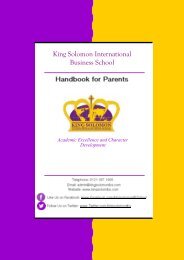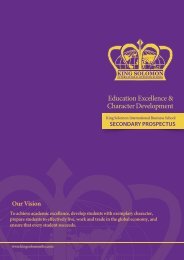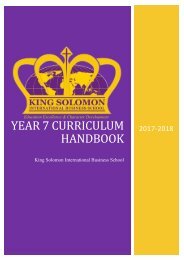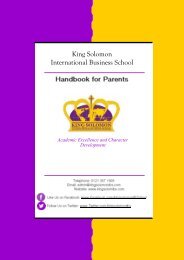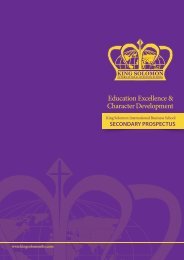Year 8 Curriculum Handbook
You also want an ePaper? Increase the reach of your titles
YUMPU automatically turns print PDFs into web optimized ePapers that Google loves.
KS3 Art and Design lessons will have an emphasis on the visual elements, and introduce a<br />
range of materials and techniques in both 2D and 3D. Each project also has a strong basis<br />
in critical studies, allowing pupils to relate the work they produce to that of a broad range<br />
of artists and designers. Each project has scope for exploration, creativity and selfexpression,<br />
with learning objectives that include creativity and exploration of materials to<br />
produce an individual final piece.<br />
KS3 Design and Technology lessons will be rotated between a selection of specialisms to<br />
allow pupils to gain skills and understanding in a range of materials and techniques<br />
including food technology. Projects will have an emphasis of the ‘Iterative Design Process’,<br />
understanding design briefs, carrying out effective research and planning, creating<br />
prototypes, testing and evaluating. Pupils will consider how products will be used, who will<br />
use them, how much they cost and their appearance. They will develop their understanding<br />
of designing and making, and expand their practical skills.<br />
KS3 Assessment in Art and Design is based on the criteria that pupils will work towards<br />
during GCSE:<br />
AO1: Develop ideas through investigations, demonstrating critical understanding of<br />
sources.<br />
AO2: Refine work by exploring ideas, selecting and experimenting with appropriate<br />
media, materials, techniques and processes.<br />
AO3: Record ideas, observations and insights relevant to intentions as work progresses.<br />
AO4: Present a personal and meaningful response that realises intentions and<br />
demonstrates understanding of visual language.<br />
KS3 Assessment in Design and Technology is based on the criteria that pupils will work<br />
towards during GCSE:<br />
AO1: Identify, investigate and outline design possibilities to address needs and wants.<br />
AO2: Design and make prototypes that are fit for purpose.<br />
AO3: Analyse and evaluate:<br />
- design decisions and outcomes, including for prototypes made by themselves<br />
and others<br />
- wider issues in design and technology.<br />
AO4: Demonstrate and apply knowledge and understanding of:<br />
- technical principles<br />
- designing and making principles.<br />
You will be assessed formally during each cycle to determine understanding of key<br />
ideas, techniques and information.<br />
The Iterative<br />
Design Process:



